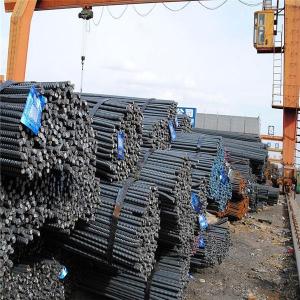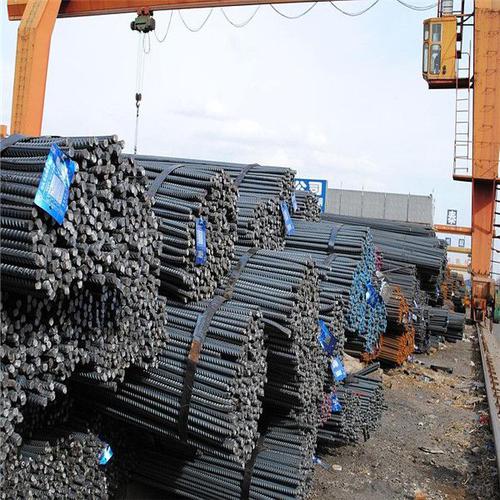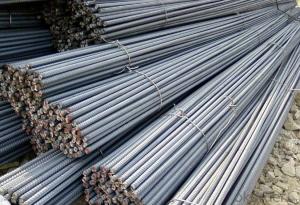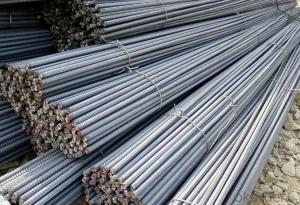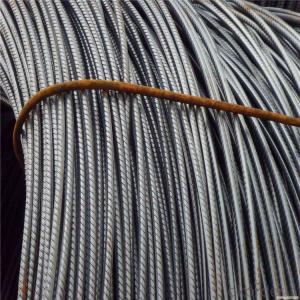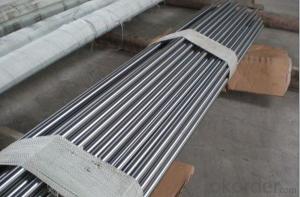Steel rebar Grade HRB400 for Construction
- Loading Port:
- China main port
- Payment Terms:
- TT OR LC
- Min Order Qty:
- 100 m.t.
- Supply Capability:
- 19000 m.t./month
OKorder Service Pledge
OKorder Financial Service
You Might Also Like
Specification
Steel rebar is metal bars often used in construction for pouring concrete or supporting walls and columns. The rebar can
be smooth, though they are frequently manufactured with deformations that create greater texture to which concrete can
adhere, creating a stronger bond that helps prevent cracking of concrete. These deformations do not create weaknesses in
the rebar, and when rebar is measured to determine its diameter, it is typically measured at the narrowest point. Strength
grades indicate the amount of pressure the steel rebar can withstand, and grade and diameter are typically presented in both
imperial and metric units.
Features
1、Pure steel quality, stable chemical contents, small tolerance.
2、Constant Quality, good drawing performance.
3、High dimension accuracy degree, accuracy degree of Level C up to 80%, smooth surface, less scale, easy to be pickled.
4、Automatic bundling with 4 lines by Machine in tidy and good looks
5、Big high quality percentage, small coil percentage, and heavy coil weight for Hard Coil.
6、High sorbitizing percentage.
Product Description :
Chemical composition (%): | Steel | C | Si | Mn | P | S | Ceq | ||||
HRB335 |
0.25 |
0.80 |
1.60 |
0.045 |
0.045 | 0.52 | |||||
HRB400 | 0.54 | ||||||||||
HRB500 | 0.55 | ||||||||||
Mechanical properties | Steel | Rel/ MPa | Rm/ MPa | A/ % | Agt/ % | ||||||
≥ | |||||||||||
HRB335 | 335 | 455 | 17 |
7.5 | |||||||
HRB400 | 400 | 540 | 16 | ||||||||
HRB500 | 500 | 630 | 15 | ||||||||
Package: | Standard export packing or as customer's request | ||||||||||
Application: | Construction, building, bridge, road. ect | ||||||||||
Payment terms | 1).100% irrevocable L/C at sight. | ||||||||||
Delivery time | 15-30 days after receipt of L/C or deposit by T/T | ||||||||||
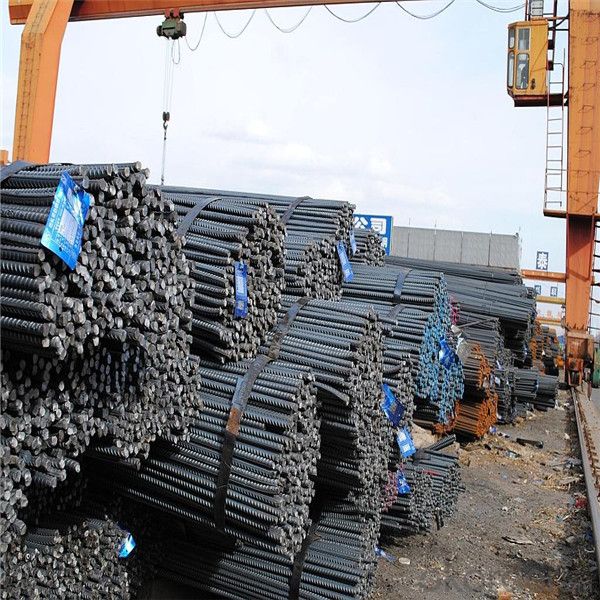

Packing:
In bundles, each bundle weight 3.5 tons. Load by container or by bulk verssel.
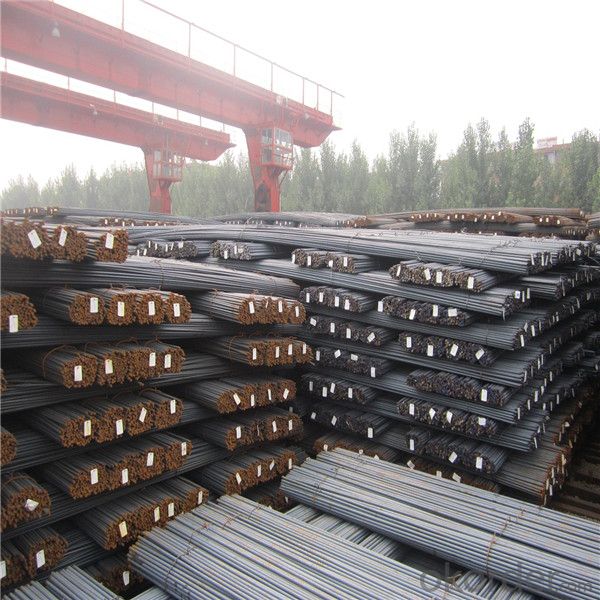
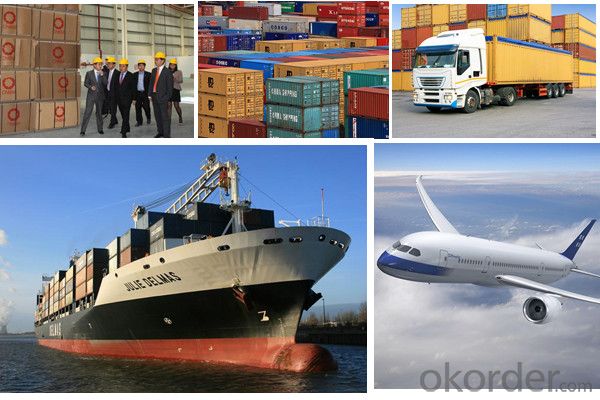
Our service
(1) We cooperate with famous factories with advanced equipment and well trained workers.
(2) We can provide factory price with trading company service.
(3) We continuously work on the improvement of our processes, guaranteeing consistently high standards
of quality to keep none compensation.
(4) We guarantee 24 hours response and 48 hours solution providing service.
(5) We accept small order quantity before formal cooperation.
(6) We deliver the agreed quality at the agreed time, reacting to changes in customer wishes in a flexible way.
(7) Due to our volume and selling power, we have excellent freight rates with shipping lines.
(8) We strive to always be fair and honest in our dealings with customers.
(9) We strive to work together with customers to achieve much more than we can achieve alone.
(10) Through our passion and commitment we aim to be a market leader in all our key markets. To maintain
our position as market leader we must continue to add value in all that we do.
FAQ:
1.Q: What's your MOQ(minimum order quantity)?
A: One full container, mixed acceptable .
2. Q: What's your packing methods?
A: Packed in bundle or bulk ..
3. Q: How can I buy CNBM products in my country?
A:Please send us an inquiry or email ,we will reply to you if there is distributor in your country
4. Q: Can we visit your factory?
A: Warmly welcome. Once we have your schedule, we will arrange the professional sales team to follow up your case.
5. Q: How long does it take to get the product if i place an order?
A:With the process of your requirements,we will pack and deliver in 3-7 days. If it is by sea shipment,it will take 15-45 days depending on different locations
- Q: What is the effect of welding on the properties of steel rebars?
- The effect of welding on the properties of steel rebars can vary depending on several factors. Firstly, welding can introduce heat into the rebars, which may cause localized changes in the material's microstructure. This can lead to changes in the rebars' mechanical properties, such as hardness and strength. The heat-affected zone (HAZ) near the weld can experience changes in grain structure, which may affect the rebars' ability to withstand tension, compression, or bending forces. Secondly, the welding process can introduce residual stresses into the rebars. This occurs due to the expansion and contraction of the material during the heating and cooling phases of welding. Residual stresses can potentially affect the rebars' performance under load, as they can increase the susceptibility to cracking or failure. Furthermore, welding can also introduce defects such as porosity, inclusions, or lack of fusion if not performed properly. These defects can weaken the rebars and reduce their load-bearing capacity. Additionally, the presence of welding consumables and fluxes can introduce impurities into the rebars, which may affect their corrosion resistance. Overall, while welding can be an effective method for joining steel rebars, it is crucial to consider the potential effects on their properties. Proper welding techniques, including preheating, controlling heat input, and post-weld heat treatment, can help minimize these effects and ensure that the rebars maintain their desired mechanical and structural properties. Regular inspections and testing of welded rebars are also important to ensure the integrity and safety of the overall structure.
- Q: How are steel rebars used in reinforcement cages?
- Steel rebars are used in reinforcement cages to provide strength and stability to concrete structures. They are placed in a grid-like pattern and then tied together to form a cage-like structure. These rebars help to distribute the load evenly throughout the structure, preventing cracks and improving its overall strength.
- Q: What is the difference between hot-rolled and cold-worked steel rebars?
- Hot-rolled steel rebars are produced by heating the steel billet to high temperatures and then passing it through rollers to shape and form it. This process results in rebars with a rough surface and varying dimensions. On the other hand, cold-worked steel rebars are produced by subjecting the hot-rolled rebars to a process called cold working, which involves further shaping and sizing by passing them through dies or rollers at room temperature. This process results in rebars with a smoother surface, tighter dimensional tolerances, and increased strength.
- Q: How do steel rebars contribute to the structural soundness of a building?
- Steel rebars contribute to the structural soundness of a building by providing reinforcement to concrete structures. By adding strength and stability to the concrete, rebars help prevent cracks and structural failures, especially during heavy loads, seismic activities, or extreme weather conditions. They enhance the tensile strength of concrete, which is otherwise weak in tension, and allow it to withstand greater forces, thereby increasing the overall durability and longevity of the building.
- Q: What are the advantages of using epoxy-coated steel rebars?
- Using epoxy-coated steel rebars in construction projects has several advantages. Firstly, the epoxy coating provides excellent corrosion resistance, protecting the rebars from moisture, oxygen, and other environmental elements. This extends their lifespan and enhances the durability of the structure. Secondly, epoxy-coated steel rebars offer improved bonding strength due to their rough surface. This enhances the adhesive properties between the rebar and the concrete, resulting in better load transfer and strengthening the structure. It also reduces cracking and improves the overall structural integrity. Another advantage is their ability to resist chemical attack. The epoxy coating acts as a barrier, preventing direct contact between the steel and chemicals in environments like wastewater treatment plants or industrial facilities. This helps maintain the structural integrity over time. Additionally, epoxy-coated steel rebars are easier to handle and install. The smoothness of the coating reduces friction, making it easier to position and place the rebars accurately. This simplifies the construction process, increases productivity, and reduces labor costs. Lastly, epoxy-coated steel rebars offer aesthetic benefits. The coating can be customized to different colors, allowing for better visual integration with architectural designs. This is particularly useful in projects where the rebars are visible, such as bridges or artistic structures. In conclusion, using epoxy-coated steel rebars provides corrosion resistance, improved bonding strength, chemical resistance, easier handling and installation, and aesthetic benefits. This leads to enhanced durability, reduced maintenance costs, and improved structural performance in construction projects.
- Q: How are steel rebars used in industrial buildings?
- Steel rebars are used in industrial buildings to reinforce concrete structures and enhance their strength and durability. They are typically embedded within the concrete to provide additional support and prevent cracking or collapse under heavy loads or seismic activity. Rebars help to distribute the load evenly throughout the structure and ensure its structural integrity, making them vital components in the construction of industrial buildings.
- Q: Can steel rebars be used for both residential and commercial construction?
- Steel rebars can serve for both residential and commercial construction purposes. They are widely employed as reinforcement in concrete structures to enhance their robustness and stability. Steel rebars are suitable for diverse construction endeavors such as residential buildings, commercial establishments, bridges, and infrastructure projects. By incorporating steel rebars, the concrete structure becomes capable of withstanding considerable loads, seismic activity, and other external forces. Regardless of whether it is a modest residential dwelling or a substantial commercial complex, steel rebars are a dependable and extensively utilized material for reinforcing concrete structures in both residential and commercial construction settings.
- Q: What are the different types of steel rebars used in marine construction?
- The different types of steel rebars used in marine construction include epoxy-coated rebars, stainless steel rebars, and galvanized rebars. Epoxy-coated rebars are commonly used in marine environments due to their corrosion resistance properties. Stainless steel rebars are also used for their excellent corrosion resistance and strength. Galvanized rebars, which are coated with a layer of zinc, are another option for marine construction as they provide good protection against corrosion.
- Q: What are the common manufacturing processes for steel rebars?
- Steel rebars are manufactured through a series of steps to guarantee the production of durable and high-quality reinforcement bars. These steps usually consist of the following: 1. Melting: Initially, raw materials such as iron ore, coal, and limestone are melted in a blast furnace. This process yields molten iron, which is further refined to eliminate impurities. 2. Casting: Subsequently, the refined molten iron is poured into molds, creating large billets or blooms. These molds, commonly known as continuous casting machines, solidify the molten iron into a rectangular form. 3. Rolling: The solidified billets or blooms are then heated and passed through rolling mills. Through this rolling process, the steel is compressed between a series of rollers, reducing its thickness and shaping it into the desired dimensions of rebars. Additionally, this process enhances the mechanical properties of the steel while eliminating any internal defects or impurities. 4. Quenching and Tempering: Following the initial rolling, the rebars may undergo quenching and tempering. Quenching involves rapidly cooling the steel bars by immersing them in water or oil. This step increases the hardness of the rebars, making them more resistant to deformation and wear. Subsequently, tempering involves reheating the quenched bars to a specific temperature and gradually cooling them. This process eliminates internal stresses and improves the toughness of the rebars. 5. Cutting and Coiling: Once the rebars have been rolled and heat-treated, they are cut to the desired lengths using cutting machines. The cut rebars are then either coiled into bundles or stacked for storage and transportation. 6. Surface Treatment: Manufacturers often apply a protective coating or surface treatment to enhance the corrosion resistance of rebars. This can be achieved through hot-dip galvanizing, where the rebars are immersed in molten zinc to form a zinc coating, or epoxy coating, where a layer of epoxy resin is applied to the rebars. It is crucial to note that these manufacturing processes may vary depending on the specific requirements and standards set by different countries and industries. Nevertheless, the aforementioned steps provide a general overview of the common processes involved in manufacturing steel rebars.
- Q: What is the impact of steel rebars on the construction timeline?
- The construction timeline is greatly affected by steel rebars. These rebars are essential in reinforced concrete structures and provide strength and durability to the overall construction. It is crucial to properly install and integrate them into the concrete elements to ensure the building's structural integrity. To begin with, delays in procuring or delivering steel rebars can have a significant impact on the construction timeline. This can cause a ripple effect, postponing or slowing down construction activities that require the presence of rebars, such as formwork, concrete pouring, and curing. As a result, the overall construction timeline may be delayed. Furthermore, the installation of rebars is a meticulous and time-consuming process. Construction teams must accurately place and secure the rebars according to design specifications and engineering drawings. This involves cutting, bending, and tying rebars to create the necessary reinforced structures. Any errors or rework needed during this phase can lead to additional time being spent, potentially causing delays in subsequent construction activities. In addition, coordination between different construction trades is crucial when working with rebars. The integration of electrical and plumbing systems with rebars must be done correctly before pouring the concrete. Miscommunication or lack of coordination can result in conflicts and rework, causing delays in the construction timeline. Moreover, the quality of rebars is vital to the construction timeline. Poor quality or defective rebars can pose safety concerns and potential structural issues. In such cases, remedial actions, such as removing and replacing faulty rebars, need to be taken, leading to delays and additional costs. In conclusion, steel rebars significantly impact the construction timeline. Factors such as availability, timely delivery, accurate installation, coordination with other trades, and quality influence the overall progress of a construction project. Proper planning, communication, and monitoring are essential to effectively incorporate rebars into the construction process, minimizing potential delays, and keeping the project on schedule.
Send your message to us
Steel rebar Grade HRB400 for Construction
- Loading Port:
- China main port
- Payment Terms:
- TT OR LC
- Min Order Qty:
- 100 m.t.
- Supply Capability:
- 19000 m.t./month
OKorder Service Pledge
OKorder Financial Service
Similar products
Hot products
Hot Searches
Related keywords
